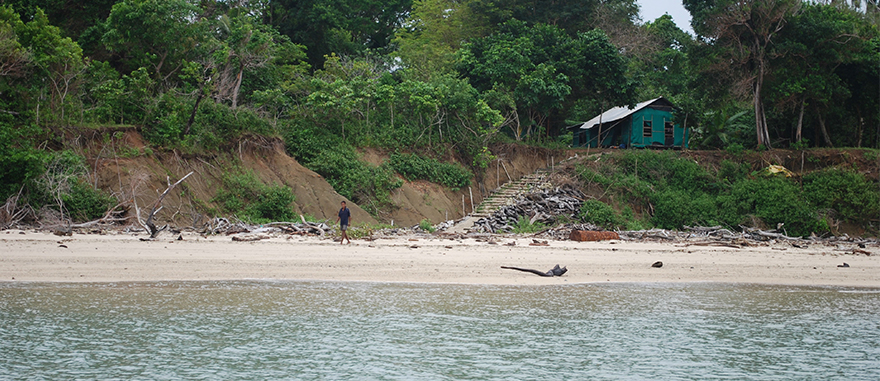The house that Gopinath built
Gopinath Jeem is a modern day Robinson Crusoe; not as a result of any shipwreck or accident but by a determined and desperate choice. Here is a man who is asserting his right NOT to be pushed off the beaten path, while his people are being led astray and torn asunder. Here is a man who has stood up against the might of the Indian bureaucrats and made it plain to them: ‘’If you can’t deliver what we need, then just buzz off’’. To plough, a lonely furrow takes far more than physical courage. Indeed Gopinath Jeem is a man to be commemorated.
The tsunami of December 2004 is, by now, a well-documented event. Though not much can be added to this archive by way of new information, the devastations that have followed in its wake continue to throw up stories of typical official bungling on the one hand and of heart-warming stoic courage on the other. The Nicobar group of islands, a treasured Indian possession in the middle of Bay of Bengal, took the blow of the tsunami right on its chin and came off rather badly. Here is one such story from there.



The natives of this group of Islands – Christians mostly – are a simple people leading uncomplicated lives. Their world is far removed from ours. With their settlements lined along the coast, their dependence upon the sea is self-evident. For variety, they maintain a small number of livestock like goats, pigs and chickens. The only paid work they have been doing for centuries is making and selling copra to the markets at Port Blair. Their family structure and value systems are beyond our comprehension. Everybody is so closely knit; there is no concept of an orphan. Volumes can be (and have been) written about them but that would take the focus away from the purpose and theme of this article.
Interestingly, It was their traditional dwellings that were the least understood by people, appointed to rehabilitate them; the new modern ones – elegant to look at – appear to be an insensitive solution and poses a serious threat of annihilating a fragile culture.
A typical house – machan – resembling a domed haystack, is built above ground on palm stilts with a short ladder to reach a slatted floor. This smart flooring regulates the velocity of the sea breeze and very cleverly allows the occupants to, both, keep an eye on their animals at night as well as feed them from the top through the gaps. The windowless enclosure, made of Dhani Patti leaves and thatch easily triumphs over the monsoon rains and the stiff sea breezes. The inside of this dome offers abundant storage space so that their paraphernalia actually dangles from above leaving the floor to do its business of ventilating. And as for toilets, the whole hinterland is available.
There is nothing to fear from earthquakes since there is hardly anything murderous that can fall on their heads. Once in a while, these structures are given a little playful shake that skews them to one side. The occupants respond to this by just pushing them back to plumb. Being skilled carpenters, reassembly is easy in case of any serious damage.



But the tsunami was a different matter; much more sinister and much more devasting. By destroying the landscape it either removed or delayed the rejuvenation of those resources – coconut trees, for example – that would have helped their early re-entry back to normality.



Then the government of India stepped in – doling out money to people who didn’t know what to do with it. In no time the tribals were inexorably set on the road to consumerism by unscrupulous vendors from the Mainland. In no time their bank accounts were cleaned up in buying things like second-hand bikes to emergency lights, at prices they had no idea about.
Worse was to follow. The bureaucrats, as a safeguard against another tsunami and without proper consultation with the beneficiaries (of the shattered Trinket Island), relocated them on higher ground; away from the coast on another island (Kamorta Island), compounding their errors one after another. Very immaculate looking, dozens of 1-BHK twin houses were constructed, whose inadequacy was proven straightaway. There was no place for their livestock; they didn’t know how to use the toilet or the plumbing or the joinery; the built-up area was uselessly partitioned to create meaningless cubby holes; the settlement was too far away from the coast; they were forced to do daily-wage work, under the Rural Employment Scheme, they hadn’t done before and didn’t like doing now. These and a few more factors altered the life of the tribals so much they were numbed into inaction. But not Gopinath Jeem. He saw what was coming, cautioned his people about the impending danger and when they paid no heed, went back to Trinket Island all by himself, and started all over again.



All he wanted (and needed) was tools to rebuild his home, on its original location and carry on as before.



If your ears are not on the ground you can’t possibly hear local voices. To start a primitive, helpless people on a journey into the 21st century and then abandon them with no follow-up action can only be described as brutal. The tribals now listen to Bollywood songs, whose meanings they don’t understand; smoke cigarettes they can’t afford; use bikes they can’t repair; have become dependent on medicines that are not available; keep livestock that is constantly running away and live in houses they can’t fix. Having become used to free food for nearly two years, the net result is that this once-independent community has now developed a very low self-esteem and become beggars in its own resource-rich land. It is in this context that Gopinath Jeem’s house stands out as a beacon of pride, confidence and dignity.








0 comments